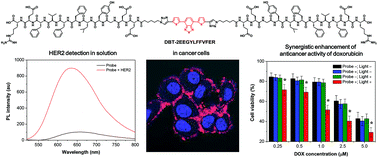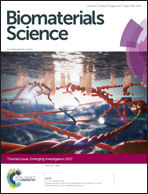A specific environment-sensitive near-infrared fluorescent turn-on probe for synergistic enhancement of anticancer activity of a chemo-drug†
Abstract
Chemotherapy is one of the main categories of clinical cancer treatment. One of the hindrances of a popularly used chemo-drug doxorubicin (DOX) is that some types of cancer cells are or become insensitive/resistant to DOX. In this work, we report a near-infrared (NIR) fluorescent turn-on probe DBT-2EEGYLFFVFER by conjugation of an environment-sensitive fluorophore DBT with human epidermal growth factor receptor 2 (HER2) specific binding peptides. Besides the NIR fluorescence turn-on signature, DBT-2EEGYLFFVFER also has activatable capability of reactive oxygen species (ROS) generation. DBT-2EEGYLFFVFER is weakly fluorescent in aqueous solution and hardly produces ROS under white light irradiation. However, both the NIR fluorescence and ROS production ability can be switched on when DBT-2EEGYLFFVFER binds to HER2 proteins overexpressed in cancer cells. Besides specific visualization of HER2-expressed cancer cells, DBT-2EEGYLFFVFER upon exposure to light is able to effectively increase the intracellular ROS level and offer an intracellular oxidative microenvironment, which does not cause the death of cancer cells, but greatly and synergistically boosts the cytotoxicity of DOX against HER2-expressed cancer cells with a supra-additive effect of “0 + 1 > 1”.

- This article is part of the themed collection: Emerging Investigators 2017


 Please wait while we load your content...
Please wait while we load your content...